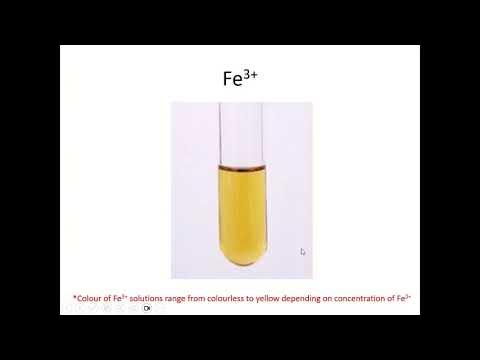P5 - Analisis Kualitatif Kation dengan Metode H2S
Summary
TLDRThis video provides a detailed tutorial on qualitative analysis using the H2S method to identify cations. It explains preliminary tests, including organoleptic examination, heating of test tubes, and flame tests, which help detect physical properties such as color, odor, and the presence of specific ions. The video also introduces various group reactions based on sample solubility, including reactions with HCl, H2S, ammonium chloride, and ammonium carbonate. These tests reveal the presence of cations from different groups, eventually leading to specific reactions that identify individual cations such as lead, silver, or mercury.
Takeaways
- 🔬 The video is about qualitative analysis or identification of cations using the H2S method.
- 👀 The first step is a preliminary test, which includes organoleptic examination, tube heating, and flame testing.
- 👃 Organoleptic examination involves checking the form, smell, and color of the sample using the senses.
- 🔥 Tube heating is performed to observe color changes in the solid sample when heated in a test tube.
- 💥 The flame test involves burning a nickel-chromium wire to observe specific colors emitted by cations.
- ⚗️ After the preliminary tests, the sample undergoes group reactions, starting with group 1 using diluted HCl.
- ⚡ Group 1 cation detection results in a white precipitate, while group 2 uses H2S to test for black, yellow, orange, or brown precipitates.
- 🧪 Group 3 testing involves adding ammonium chloride and ammonium hydroxide, with black, white, green, or pink precipitates indicating specific cations.
- 💧 Group 4 testing uses ammonium carbonate and looks for white precipitates to indicate group 4A cations.
- 🔍 A specific reaction for cation identification follows after group testing, determining the exact cation present, such as lead, silver, or mercury.
Q & A
What is the main topic of the video?
-The video discusses qualitative analysis or cation identification using the H2S method, focusing on various stages of testing.
What is included in the preliminary tests during cation identification?
-Preliminary tests include organoleptic examination, heating of test tubes, and flame tests.
What does organoleptic examination involve?
-It involves examining the form, smell, and color of the sample using sensory perception, determining if it is solid, liquid, or gas, and assessing if the sample has a distinctive smell.
Why should chemicals not be smelled directly during organoleptic examination?
-Directly smelling chemicals can be harmful, so caution is advised during the organoleptic examination.
How is the test tube heating performed, and what does it indicate?
-A solid sample is placed in a test tube and heated. Any color change may provide clues about the sample's composition, as outlined in the corresponding analysis table.
How is the flame test conducted?
-A clean nichrome wire is dipped in concentrated HCl, burned until the flame color is constant, and then dipped into a finely powdered sample before being exposed to a flame. The emitted flame color helps identify specific cations.
What is the next step after preliminary testing in cation analysis?
-The next step is the group reaction, which involves testing specific groups of cations using wet reactions.
How is Group 1 cation identification performed?
-Group 1 cations are tested by reacting the sample solution with dilute HCl. If a white precipitate forms, the sample contains Group 1 cations.
What indicates the presence of Group 2 cations?
-The sample is reacted with H2S and dilute HCl. If a colored precipitate such as black, yellow, orange, or brown appears, it indicates Group 2 cations.
How can Group 4 cations be identified?
-Group 4 cations are identified by reacting the sample solution with ammonium carbonate, ammonium chloride, and ammonium hydroxide. A white precipitate suggests the presence of Group 4A cations.
Outlines

Этот раздел доступен только подписчикам платных тарифов. Пожалуйста, перейдите на платный тариф для доступа.
Перейти на платный тарифMindmap

Этот раздел доступен только подписчикам платных тарифов. Пожалуйста, перейдите на платный тариф для доступа.
Перейти на платный тарифKeywords

Этот раздел доступен только подписчикам платных тарифов. Пожалуйста, перейдите на платный тариф для доступа.
Перейти на платный тарифHighlights

Этот раздел доступен только подписчикам платных тарифов. Пожалуйста, перейдите на платный тариф для доступа.
Перейти на платный тарифTranscripts

Этот раздел доступен только подписчикам платных тарифов. Пожалуйста, перейдите на платный тариф для доступа.
Перейти на платный тарифПосмотреть больше похожих видео

O-Level Chemistry | 16 | Qualitative Analysis [1/3]

CH181 Qulaititave analysis of group 1 cations

Salt Analysis Preliminary Tests Edunovus Online Smart Practicals

9701 Chemistry Paper 3 Qualitative Analysis - Part 1 Coloured Cations

KIMIA ANALITIK: PENGANTAR ANALISIS KUALITATIF

Exam tips to practical paper 3 A levels05: Virtual Qualitative analysis practical/A levels chemistry
5.0 / 5 (0 votes)
